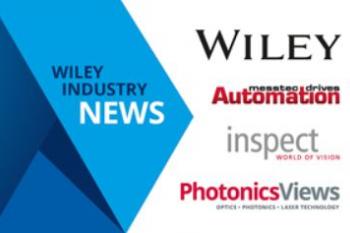“Easy integration and flexibility are becoming increasingly important”
22.04.2025 - Interview with Ulf Schulmeyer, Product Manager Merlic at MVTec, and Dr. Stefan Meier, Ecosystem Manager for Industrial Edge at Siemens
In this interview, Ulf Schulmeyer from MVTec and Dr. Stefan Meier from Siemens explain how machine vision apps facilitate the integration of machine vision into manufacturing automation. They discuss the challenges posed by the shortage of skilled workers and demonstrate how such user-friendly and flexible solutions can help overcome them. MVTec's Anomaly Detection for Visual Inspection app is currently available in the Siemens Industrial Edge ecosystem. But this is just the beginning.
inspect: What challenges do you see in the integration of machine vision into manufacturing automation?
Ulf Schulmeyer, MVTec: As in many other areas, the ongoing shortage of skilled workers is a determining factor here. The number of machine vision experts is not growing as fast as automation, i.e., the actual applications of machine vision in manufacturing and its integration. This means that more and more non-experts want and need to work with these applications. In order for software to facilitate this transition, the software must be intuitive and easy to use. From a holistic perspective, the easy integration and flexibility of hardware and software components are becoming increasingly important.
inspect: What are the benefits of the Siemens Industrial Edge ecosystem in this context?
Dr. Stefan Meier, Siemens: Siemens Industrial Edge is an easy-to-use, IT-secure, and, above all, scalable edge computing solution for industrial applications that consists of a ready-to-use hardware and software infrastructure, as well as other optional applications. This centrally manageable, microservices-based architecture uses state-of-the-art IT standards, such as Docker or MQTT, and brings these technologies close to the manufacturing and automation processes in the factory. Depending on the objective – such as equipping machines or lines with predictive maintenance, IT system connectivity, or quality monitoring – different combinations of industrial edge apps and devices are used to create a customized solution. With the Industrial Edge ecosystem, Siemens is pursuing an open approach in which industry-proven solutions from third-party providers and Siemens can be combined and seamlessly integrated into automation systems. Users can select the appropriate software components, for example from MVTec, in the ecosystem's marketplace, a kind of app store.
inspect: What are the advantages for vision users?
Schulmeyer: Machine vision users benefit greatly from the integrability: all the elements they find in the marketplace work together seamlessly out-of-the-box. As complete machine vision solutions can be assembled effortlessly, customers save time and money.
Meier: Moreover, Industrial Edge's app and device management allows manufacturing companies and machine builders to roll out all software configurations and updates to all devices in use with just a few clicks. This maximizes efficiency during rollout and maintenance of the customized solution. The user is also always up to date in terms of IT security.
inspect: Can you explain how the collaboration between Siemens and MVTec led to the development of the Anomaly Detection for Visual Inspection app?
Schulmeyer: During numerous discussions between Siemens and MVTec about the challenges in machine vision, it became clear that use cases and customer requirements are extremely diverse and require flexible and adaptable solutions. Furthermore, a low entry barrier to machine vision software is becoming increasingly important. The software must be extremely effective, yet user-friendly and easy to operate. MVTec Merlic has been meeting exactly these requirements for years.
That's why we decided to incorporate Merlic's state-of-the-art functionalities, namely AI-supported anomaly detection, into the first machine vision app in the Industrial Edge ecosystem. Thus, the Anomaly Detection for Visual Inspection app was born. Training requires only a few good images, which are generally easy to obtain. There is also no need for time-consuming labeling. Plus, the app is ideal for use cases where the high variability in the characteristics of possible defects makes them difficult to predict. Such an application would simply not be feasible without AI. But this was just the first step, our minimum viable product in the ecosystem.
inspect: What applications is this app intended for? Are the functions comparable with the Halcon Anomaly Detection function?
Schulmeyer: Yes, anyone familiar with Halcon’s Global Context Anomaly Detection” will recognize the similarities in the app. It addresses all applications related to anomaly detection. These are mainly inspections, for example for defect detection.
inspect: What applications has the app been used for so far?
Schulmeyer: The technology is used in semiconductor production as well as in the manufacture of fast-moving consumer goods (FMCG) and in the food & beverages and pharmaceutical sectors.
spect: Which user group(s) is the solution aimed at?
Schulmeyer: The app is aimed at users who want to create their applications within the Siemens world and use machine vision to inspect surfaces for defects automatically, precisely, and robustly, for example in quality control. Since the app is very intuitive and does not require any programming knowledge, it is also aimed at beginners or non-experts in the field of machine vision.
inspect: The collaboration between MVTec and Siemens was presented to the public at the SPS 2023 and 2024 trade fairs, including the Anomaly Detection App in action. What are the next steps in this collaboration?
Schulmeyer: MVTec Merlic will soon be fully available on Siemens Industrial Edge. This will provide a complete toolbox for implementing your own machine vision applications in a no-code development environment – classic rule-based methods and modern deep learning technologies. Their combination in particular delivers robust results, even for time-critical applications.
We owe this further step to the highly motivated, excellent cooperation with Siemens. We approach the individual companies together and advise them from different perspectives to find out exactly which use cases they have and how we can support them profitably. MVTec brings almost 30 years of machine vision expertise to the table and thus ideally complements the Siemens portfolio.
inspect: The integration of Merlic into the Siemens Industrial Edge ecosystem means not just another MVTec app, but a new level, because any apps created with Merlic can be seamlessly delivered on the Siemens Edge. How did this step come about?
Schulmeyer: For us, it is a logical consequence of the first app’s development. Merlic can do so much more than “just” anomaly detection, even though this is one of the features with the most use cases. The solution-oriented simplicity and user-friendliness of Merlic, without the need for coding, is a great conceptual fit with the Siemens Industrial Edge ecosystem. We address the same target group. So it is only logical to provide them with the complete toolbox called Merlic.
inspect: How does the licensing model work in the Industrial Edge ecosystem? Does every Merlic app user become an MVTec customer, or does it go through Siemens?
Schulmeyer: The app is purchased via the Siemens marketplace. This creates a business relationship with MVTec and the customer benefits from all the services that MVTec offers – such as free application evaluations, feasibility studies, training, consulting, and of course support from our application engineers.
Meier: The entire procurement process is conveniently handled via the marketplace, regardless of whether the individual offerings come from Siemens or another provider, as in this case MVTec.
inspect: How complex is the ordering process?
Meier: The transactions in the marketplace work just like in the B2C app stores that we are used to on our smartphones. But in the B2B space for industrial customers, there are additional requirements that make the customer journey a bit more complex, for example:
- Interactions between buyers and sellers must comply with all relevant regulations, such as export control. Marketplace customers must provide verified legal and business information.
- There are different roles in the purchasing process of industrial companies: the person who buys the product on the Industrial Edge marketplace is not the same person who uses the product later, for example in the IT department or in the factory. In the marketplace, we try to make the user journey as simple as possible for all roles involved in the process.
- The Industrial Edge ecosystem portfolio is a complex offering with multiple levels of architecture that need to be reflected in the marketplace. Depending on the chosen solution architecture, a buyer must be assigned usage licenses for the individual software components.
It is therefore quite a challenge to find the right balance between a user-friendly and simple process experience and the requirements of the industrial environment. We are continuously working on this with the Industrial Edge ecosystem and its marketplace.
Author
David Löh, Editor-in-Chief of inspect









